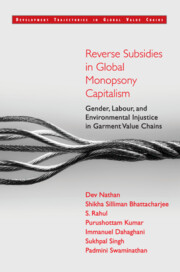 Reverse Subsidies in Global Monopsony Capitalism
Reverse Subsidies in Global Monopsony Capitalism 4 - Living Wages and Labour Subsidies
Published online by Cambridge University Press: 21 January 2022
Summary
In this part, we deal with the factory as the site of extraction of subsidies from labour. This extraction is carried out through the payment of wages below a living wage, which is the cost of producing labour power. In this chapter, we outline the concept of living wages and demonstrate their calculation for major supplier countries of Asia, such as India, Bangladesh, Sri Lanka, and China. We then compare the living wages for these countries with national minimum wages, which are often the basis for labour costing in contracts between brands and suppliers. Further, in the case of India, we also look at the actual wages paid, to see the extent of extraction of labour subsidies.
The subsidy from labour is extracted in two ways. First, through the overuse, particularly of women workers’ bodies and, second, through support to garment workers by their rural households. The first method of extracting labour subsidies, through the overuse and discard, particularly, of the bodies of women garment workers, is dealt with in Chapters 5 and 6. The second method of extraction is dealt with in Chapter 7, where we discuss the role of the rural connection in sustaining workers during times of need.
This chapter begins with an account of brand–supplier relations in garment GVCs, setting the context for the discussion of workers wages that follows. It then sets out the concept of living wages and the manner of their calculation, including how we can take account of women's unpaid domestic work. We then provide an analysis of wages in two major Indian garment clusters, along with national-level secondary data on wages in the garment sector. Using official survey data on wages and profits, we put forward the proposition that wages in supplier firms are constrained by the low level of profits earned by these firms, and the national minimum wage base of contracts by supplier firms in monopsonistic global value chain (GVC) relationships with lead firms. These firm-level characteristics that lead to low wages are reinforced by worker characteristics, such as gender and low educational levels.
Low wages in the garment industry are usually explained by features of workers in this industry—with low educational levels and a high proportion of women in the workforce.
- Type
- Chapter
- Information
- Reverse Subsidies in Global Monopsony CapitalismGender, Labour, and Environmental Injustice in Garment Value Chains, pp. 69 - 96Publisher: Cambridge University PressPrint publication year: 2022
